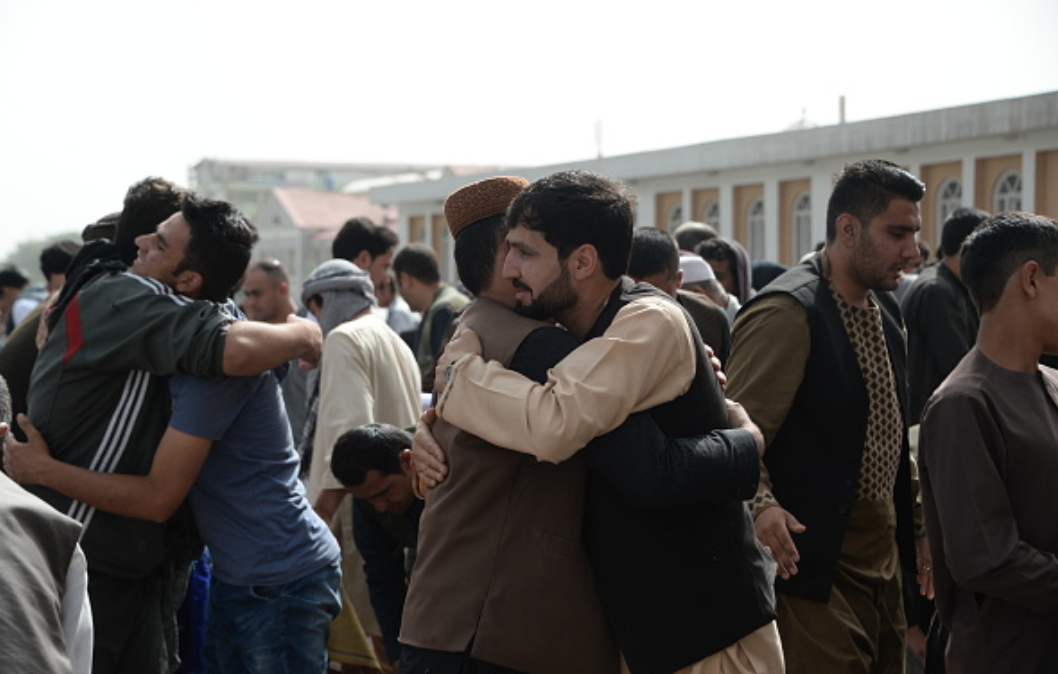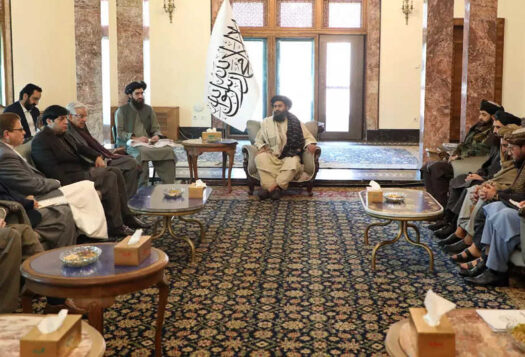
U.S. President Donald Trump’s decision to send additional troops to Afghanistan as part of his South Asia strategy was viewed by many scholars as the beginning of an indefinite end to U.S. presence in Afghanistan. Trump defined his South Asia strategy, intended to bring peace in Afghanistan, as a shift towards a conditions-based approach with increased pressure on Pakistan—a country he spoke of as providing “safe haven to agents to chaos, violence and threat.” Even as he failed to specify what those conditions would be, Trump emphasized the intertwining of “diplomatic, economic, and military” means to achieve a successful outcome; that is, to coerce the Taliban to come to the table for peace talks and negotiate a political settlement with Kabul.
Although the post-South Asia strategy era witnessed an increase in troops on the ground, greater autonomy to the Pentagon, and a sharp uptick in airstrikes against the Taliban, and movements towards a peace process, it is unclear if the United States is any closer to putting an end to the war in Afghanistan. It is clear that the Taliban still maintains vast and increasing territorial control across the country and wields the ability to execute lethal attacks against Afghan and U.S. forces, as seen in the latest Taliban assault on Ghazni, which saw the death of over 20 civilians and 70 police soldiers. The progress made by the Taliban in terms of territory and large-scale attacks raise questions on the possibility of peace talks and its likely success.
The Beginning of the End?
According to Defense Secretary James Mattis, the South Asia Strategy, now a year old, is working. In recent remarks, Mattis emphasized the importance of the “reconciliation pillar” of the strategy. This was likely influenced by one particular development: the Afghan Taliban agreeing to reciprocate the Eid ceasefire declared by the Afghan government. The surprising three-day ceasefire between the Afghan government and the Taliban in June—the first formal ceasefire since 2001—was a watershed moment in the U.S. push towards peace talks. Some analysts thought that showing Taliban fighters performing prayers with Afghan National Security Forces were signs that the Taliban fighters might be ready for peace. Skeptics, however, believed that such episodes of camaraderie were exaggerated and should not be viewed as a pathway to a long-term peace process.
Nonetheless, the Eid ceasefire has been significant, at least in terms of launching negotiations with the Afghan Taliban. Reports have surfaced of United States officials holding direct meetings with Taliban officials with the aim of setting up peace negotiations. This is notable as it marked a shift away from the United States’ once-staunch opposition to direct talks with the Taliban and its support for an “Afghan-led” and “Afghan-owned” peace efforts. This shift in U.S. attitudes towards the Taliban may be worthwhile, especially if U.S. policymakers see this as a way to begin a peace process with the Taliban. Additionally, the Eid ceasefire saw an increased willingness on the part of the United States to discuss the Taliban’s major prerequisite to talks: the reevaluation of foreign troop presence in Afghanistan.
These developments are largely positive, but carry with them some risks. For instance, analysts have speculated that President Trump’s exhaustion with the war may be one of the many reasons behind last year’s South Asia strategy announcement. His reported reluctance to send troops “everywhere” raises fears regarding the possibility of the United States hastening the process of talking to the Taliban. Through direct talks with the Taliban, the United States risks undermining the legitimacy of the Afghan government, which the Afghan Taliban considers a puppet of the U.S. government. The move could embolden the Taliban and strengthen its legitimacy to uphold a parallel government. Additionally, any kind of agreement by the United States on the withdrawal of U.S. troops could further tilt the Afghan war in favor of the Afghan Taliban. As confirmed by U.S. intelligence officials, the Afghan forces are incapable of preventing the Afghan Taliban from establishing its claiming over territories.

Sidelining Regional Players
Trump’s South Asia strategy has been counterproductive to the peace process with the Taliban, as it has sidelined a potentially useful Pakistan and other major regional stakeholders like Russia and China. Indeed, the strategy did not end up compelling Pakistan to withdraw its support for the Afghan Taliban. If anything, the intense pressure on Pakistan and the United States’ perceived closeness with India may put the United States on lesser footing in the region: Pakistan’s decisions in Afghanistan will undoubtedly continue to be dictated by its security calculations, and this may include backing the Taliban. Any move that marginalizes the status of Pakistan in Afghanistan could lead the former to play spoiler to peace negotiations. Pakistan’s potential usefulness in an Afghan peace process was visible during the Eid ceasefire when the United States reached out to Pakistan to help facilitate the event.
The United States’ decision to reach out to the Afghan Taliban without taking regional countries into confidence has certainly affected its ability to pursue a regional consensus in the region. Interestingly, the South Asia strategy announced last year did not mention other regional players besides India and Pakistan by name. The United States’ refusal to attend the latest Russia-led peace talks, which was supposed to be attended by Taliban but now has been postponed by Russia, signifies a continuation of this policy. Further, the United States’ deteriorating relationship with Pakistan will likely push the latter to cooperate with Russia or China, further weakening the former’s position in a future peace process. With the United States already reticent to join in on initiatives undertaken by other stakeholders, a continued lack of consensus and confidence between these stakeholders only complicates the peace process.
Success Story Negated by Attacks
While United States troop presence remains at the not-insignificant number of 14,000, a peace process with the Taliban will certainly be difficult to maneuver. Attacks such as that in Ghazni highlight the weakness of the Afghan military, which has difficulty defending itself in battle without U.S. support. This has two medium- to long-term implications for a future peace process:
First, the Islamic State-Khorasan Province (ISKP) remains one obstacle to a successful peace process. One of the major reasons for a continued troop presence in Afghanistan has been to prevent ISKP from filling the gap that would be created by hasty withdrawal. However, the United States has also been unable to check ISKP’s progression—the attack launched by ISKP during the Eid ceasefire highlights how this inability can have serious ramifications for an enduring ceasefire, and, by extension, a peace process. Although ISKP poses its own threat to the Taliban– encroaching on the latter’s supporters by questioning their commitment to jihad–its continued presence also checks the United States’ ability to carry out its goals in Afghanistan.
Second, the Taliban’s reported interest in pursuing negotiations while simultaneously waging intense attacks could be an attempt to negotiate from a position of strength. As it is, territorial gains made by the Taliban, in addition to the latest attack in Ghazni, raise doubts over the United States’ latest attempts to begin negotiations with the Taliban. If the Taliban do seek to negotiate from a position of strength, the conditions they would put forth in a future peace process might go against the interests of the Afghan government and even the United States. If translated into reality, this would not look like the kind of victory that President Trump spoke about in his South Asia strategy.
Conclusion
Amidst the chaos surrounding the recent Taliban attacks, a weak Afghan military, and upcoming parliamentary and presidential elections, the importance of continued U.S. support for the Afghan government has only increased. An assessment of Trump’s South Asia strategy one year in therefore reveals that the United States is still confronting the same problems that it did during the time of its announcement, as increasing violence and attacks carried out by the Taliban further complicate both governments’ efforts to pursue peace talks. Nevertheless, developments such as the Eid ceasefire and diplomatic talks with the Taliban, if continued, may lead to a more official beginning for peace in Afghanistan.
Editor’s Note: The United States’ Strategy in Afghanistan and South Asia, announced one year ago by U.S. President Donald Trump at Fort Myer military base in Arlington, Virginia, marked a shift in the nature of U.S. presence not only in Afghanistan, but across the region. In this four-part series, Neha Dwivedi unpacks how the South Asia strategy influenced the Afghan peace process, Bismellah Alizada explains how the policy influenced the political and security situation in Afghanistan, Shreyas Deshmukh unravels its impact on Indo-U.S. relations, while Uzair Kayani and Sikander Shah delve into its effect on U.S.-Pakistan ties. How effective were the actions undertaken by the United States after the South Asia strategy was announced, and where is U.S. policy heading one year later? Read the series here.
***
Image 1: The U.S. Army via Flickr
Image 2: Noorullah Shirzada via Getty


